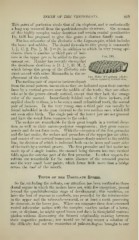Page 459 - My FlipBook
P. 459
TEETH OF THE VERTEBBATA. 469
This point of perfection rivals that of the elephant, and is undoubtedly
a long way removed from the quadritubercular structure. On account
of this highly complex molar dentition and certain cranial peculiarities
Dr. Gill has proposed to give this genus a distinct family rank.
The last sub-order of the Bodentia is the Lagoiiiorphd, which includes
the hares and rabbits. The dental formula in this group is constantly
I. \, C. ^, Pm. M. = 28, in addition to which in very young spe-
I, f
cimens there is another or third pair of inci-
sors in the upper jaw to be added to the per- ^^^- ^"^*'-.
manent set. Huxley has recently shown that
the deciduous dentition is D. I. |-, D. M. |^,
which brings this group of the Rodentia into
strict accord with other Mammalia in the re-
placement of the teeth. ... Last Molar of Capybaia {Hf,dro-
i ^ cnoerus capyoara), vertical view.
. ,
The median pan' of superior incisors depart
from the usual pattern, inasmuch as they are indented upon their anterior
faces by a vertical groove near the middle of the tooth ; they are other-
wise as in the genera already noticed, except that they lack the orange
color of the enamel. Immediately behind each of these incisors, and
applied closely to them, is to be seen a small cylindrical tooth, the second
pair of incisors. In the very young state a third pair can usually be
found imbedded in the gum external to the two median ones, which fall
out soon after birth. The single pair of the lower jaw are not grooved
and have the usual form common to the order.
The molars are remarkable for their great length in a vertical direc-
tion, as well as their antero-posterior compression ; they grow contin-
uously and do not form roots. With the exception of the first premolar
and the last molar, the molars and premolars of the upper jaw are" alike,
and consist of two vertical transverse laminse closely united in the middle
line, the division of which is indicated both on the inner and outer sides
of the tooth by a vertical groove. The first premolar and last molar are
made up of a single lamina, the enamel being thrown into two vertical
folds upon the anterior part of the first premolar. In other respects the
rabbits are remarkable for the entire absence of the coronoid process
and the very small bony palate, which forms little more than a bridge
across the roof of the mouth.
Teeth of the Ungulate Series.
So far, excluding the rodents, our attention has been confined to those
dental organs in which the molars have not, with few exceptions, passed
beyond the quadritubercular stage of development ; this condition, we
have the best of reasons to conclude, was preceded by the tritubercular
in the upper and the tuberculo-sectorial, or at least a tooth possessing
its elements, in the lower jaw. When one compares these short-crowned
rooted tubercular molars with the complex rootless molars of a horse,
cow, or elephant, he might spend hours and days in thoughtful contem-
plation without discovering the faintest relationship existing between
their respective patterns ; nor would we be any nearer a solution of
the difficulty had not the researches of palaeontologists brought to our


